14 Fun Facts About Marine Bristle Worms
In honor of the first ever International Polychaete Day, learn about the bristly worms that are everywhere in the ocean
/https://tf-cmsv2-smithsonianmag-media.s3.amazonaws.com/filer/f3/3d/f33dba44-1c27-4d97-94e4-5e9b7b4ad717/polynoidae_unidentified_watermark.jpg)
Unbeknownst to most landlubbers, polychaetes rule the seas. There are at least 10,000 species of these swimming bristly worms, some of which pop with brilliant colors or light up with a bioluminescent glow. They’ve adapted to every imaginable marine habitat, from deep hydrothermal vents to crowded coral reefs to the open ocean—and many have found ways to survive that are definitely bizarre.
It takes a unique mind to appreciate the diversity and strangeness of polychaete lifestyles, and one of the greatest belonged to Kristian Fauchald. He studied polychaetes at the Smithsonian's National Museum of Natural History from 1979 until he passed away this past April. In his career, Fauchald named three families, 34 genera and nearly 300 species of polychaetes, and he mentored and befriended far more human students and colleagues. He was so esteemed that at least 36 species have been named after him, according to the World Register of Marine Species.
In Fauchald's memory, July 1, which would have been his 80th birthday, has been declared the first International Polychaete Day. Get to know the fascinating world of his beloved organisms with these bristle worm facts:
1. Polychaetes are diversity champions
The known species of polychaetes share only a few characteristics. Each has a head, a tail and a segmented body, and typically each body segment has a pair of leg-like parapodia with spiny bristles sticking out. It's these bristles that give the worms their name: "polychaete" is Greek for "with much hair."
This simple body plan is the basis for tremendous diversity. Parapodia can be paddle-like for swimming, leg-like for walking across the seafloor or scoop-like for burrowing in the mud. The hard bristles make the worms difficult to swallow, and in some species the bristles contain venom. Polychaetes that live in tubes use their parapodia to circulate oxygenated water into tight spaces, and some have feathery external gills. Since there is an exception to every rule, some polychaetes have no parapodia at all.
2. Polychaetes have survived five mass extinctions
Polychaetes and their relatives have been around for a very long time. Paleontologists discovered the fossil species Canadia and Burgessochaeta in the Burgess Shale, a famous fossil formation that preserved many soft-bodied organisms dating back some 505 million years ago, during the Cambrian period. Like today’s polychaetes, both fossil creatures had many parapodia with feather-like bristles and sensory tentacles extending from their heads. These are among the earliest known polychaete ancestors. In the years to come, Earth witnessed five mass extinction events, one of which killed some 96 percent of all marine species. Enough polychaetes made it through all these die-offs to give rise to the abundance of species we see today.
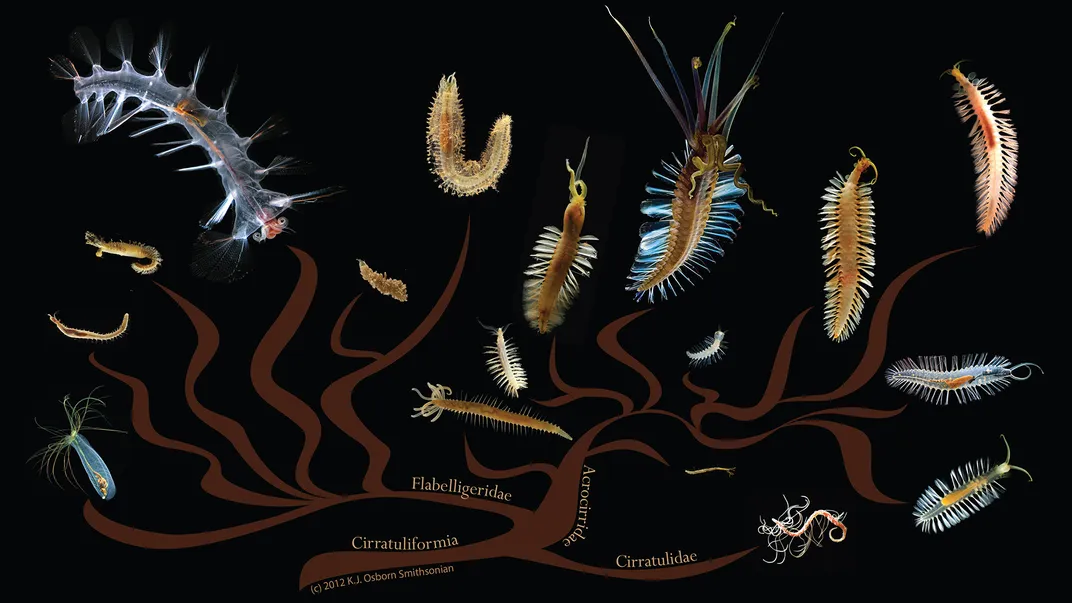
3. The Polychaete family tree is full of mystery
The earliest polychaetes evolved into the 10,000 species we know over 500 million years. That gave them a lot of time to develop differences and quirks that confound scientists’ attempts to neatly organize them and describe how the species are related.
Fauchauld dedicated his life to this problem. In 1974, he published a paper laying out the challenges in organizing polychaetes into a family tree, and he published many more in the following years. He critiqued the standard taxonomy that split the polychaetes into two groups: Errantia polychaetes (those that swim or crawl freely) and Sedentaria polychaetes (those that stay put). Too many free-swimmers evolved from stay-still polychaetes, and vice versa, for those groupings to be useful, he argued. Additionally, he noted that each taxonomist used a different trait to organize the polychaetes—comparing their mouthparts, for example. In doing so, each one created a different family tree and naming system. Collaborating with Greg Rouse, one of his many protégés, Fauchauld completed a new analysis of polychaete relationships in 1997. In the paper, they point out that their grouping is a step forward even if it is still likely incorrect, writing that "the current situation is untenable, so what is presented must be considered an improvement." That’s taxonomic progress.
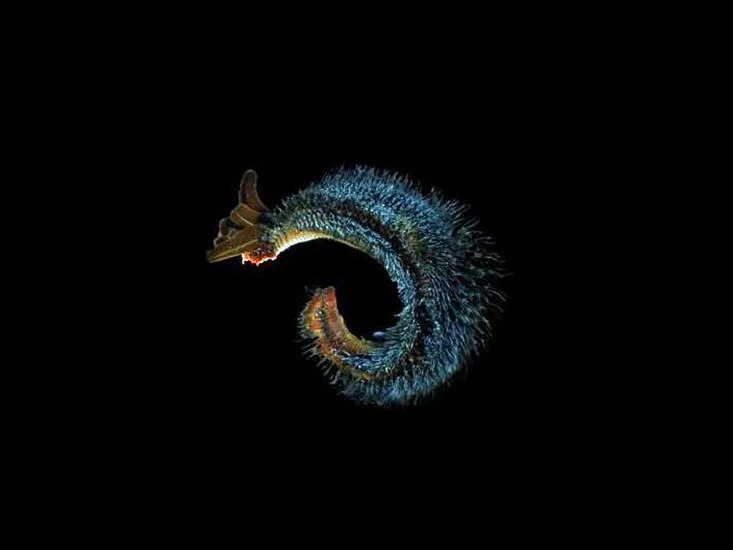
4. One of the world's most heat-resistant animals is a deep-sea polychaete
Imagine living out your days with half your body in a pot of boiling water. That’s essentially the lifestyle of the Pompeii worm (Alvinella pompejana). These tubeworms live at hydrothermal vents deep on the ocean floor, where their tails rest in hot water at temperatures of over 140 degrees Fahrenheit. Their heads, where the animals’ gills reside, stick out of their tubes, where the temperature is a much cooler 70 degrees. A 2013 study brought the worms to the surface to find out how much heat they could handle. After a challenging trip to the lab (the worms need to travel under pressure to match their deep-sea environment), researchers found that they can survive at temperatures above 107, but not for long periods of time.
Pompeii worms may have a partner in their heat resistance: Scientists believe that they have a symbiotic relationship with bacteria on their backs, which grow so densely that they form a layer one centimeter thick. The worms produce mucus that feeds the bacteria and, in exchange, the bacteria are believed to insulate the worms from the hot vent water.
5. Some polychaetes have sex lives out of a science fiction movie
Most polychaetes reproduce in a traditional marine fashion, by releasing eggs and sperm into the surrounding water. But then there's Syllis ramosa, a polychaete that lives embedded in a deep-sea sponge. This species is well adapted to a life of leisure, moving little and waiting for food to come nearby. But to mate, it has to get up, put some pants on and mingle with others of its kind at the ocean's surface. That's a long and perilous journey for a creature that doesn't swim much. Lucky for Syllis ramosa (and some other polychaete species), evolution found a way: send sexier versions to the surface to do the dangerous work of mating.
The worm's tail-end, or stolon, develops a head with no mouth and large eyes, its gut deteriorates to make room for eggs or sperm and its muscle system reorganizes to prepare for the long swim. When it's time to mate, the stolon separates from its "parent" and swims to the surface, where it releases its gamete burden before its inevitable death. Meanwhile, its counterpart soldiers on safe on the seafloor, where it can produce more stolons for the next spawning event. Stolonization only happens in a few polychaete groups, including the Syllinae and Autolytinae. In other related groups, the entire individual can transform into a swimming egg or sperm sac, called an epitoke, with its waste system modified to hold and release gametes and its eyes enlarged to sense light at the surface. If an epitoke survives its journey, its body reverts to its original state and resumes its former sedentary life until it mates again.
6. One polychaete species can survive without oxygen for 96 hours
Methane hydrates may be fairly new to our vocabulary, but they have been forming under the seafloor for millions of years. They are crystalline ice-like structures predominantly made of energy-rich methane and ice. These deposits are found around the world, yet no non-microbial life had ever been seen living on them—until the methane ice polychaete was discovered.
In 1997, a research team came across an enormous methane hydrate deposit extruding from the seafloor of the Gulf of Mexico. Exposed to the water, the scientists saw that the hydrate was crawling with tiny worms—a new species (Hesiocaeca methanicola) of polychaete. The team transported live worms from the site back to the lab and found that mature worms could survive without oxygen for 96 hours. The researchers suspect that these polychaetes survive by feeding on free-living bacteria on the gas hydrate's surface. They may also encourage the growth of their own bacterial food; their waving parapodia create water currents along the surface of the hydrate, delivering fresh oxygen for themselves and the bacteria.
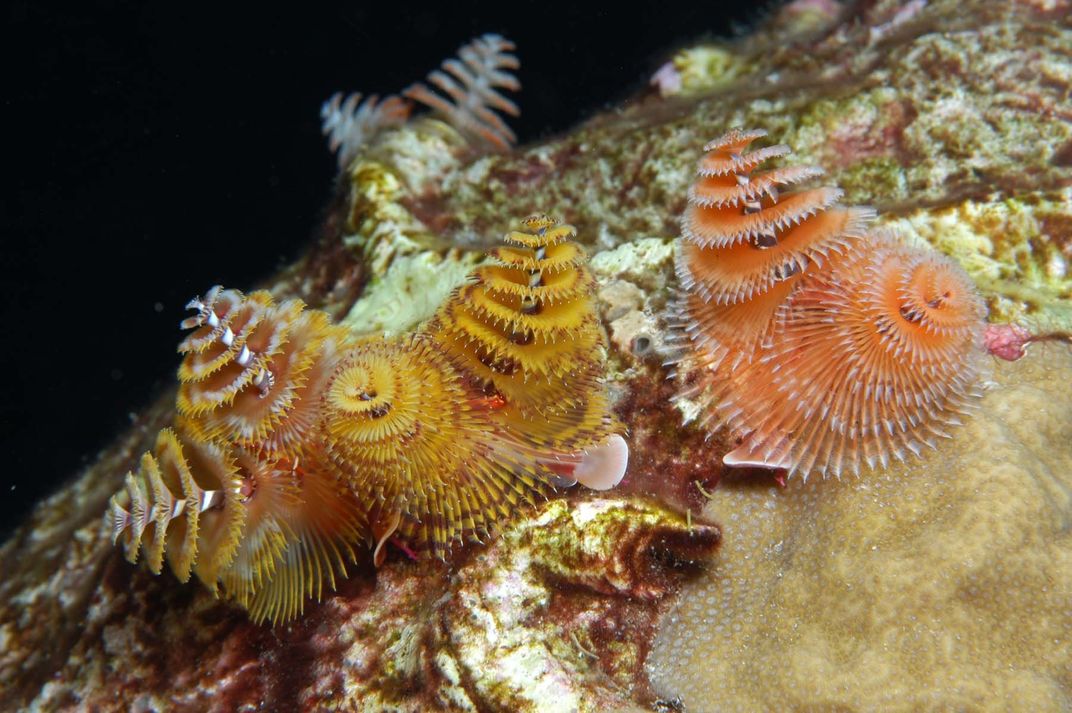
7. Emulating a Christmas tree comes easy to polychaetes
Tiny, colorful and tree-like—Christmas tree worms (Spirobranchus giganteus) dot tropical coral reefs around the world. They can be so abundant that it seems like a small forest has popped up on the stony backs of a coral reef. Most of their bodies are hidden from view, however, as they build tube homes in holes burrowed into live coral. From these tubes, they extend feathery structures called radioles, which they use to both breathe and grab phytoplankton or other small particles for dinner. When in danger, they retract their feathery headgear and hunker down in their tubes until the threat passes.
8. Polychaetes are into zombies, too
The five species of zombie worms (Osedax sp.) are named for their proclivity for eating the bones of decomposing animals on the seafloor. They've mostly been observed eating whale bones, but they don’t discriminate if other remains are available. The skin of zombie worms produces an acid that dissolves bone so that they can reach the fats and protein buried within. With no mouth or stomach, the worms rely on a root system of sorts. They drill their roots into the bone, and symbiotic bacteria living on the roots help them digest their food. Exactly how the nutrients make their way to the zombie worm still isn't clear to scientists.
Female zombie worms are the only ones that we see decorating the surface of the bone; male zombie worms are microscopic and live inside the female. Hundreds of tiny male specimens have been found in one female worm, which removes the stress of attempting to find a mate on scattered bones in the deep ocean.
9. The biggest polychaete is ten feet long
Most polychaetes are small animals, but not the bobbit worm (Eunice aphroditois). Reaching lengths of ten feet, this polychaete worm is taller than your average human by a long shot. If that isn’t terrifying enough, the bobbit worm is a stealth predator. Almost all of its lengthy body lies hidden beneath the seafloor. Five antennae on its head sense fish or other worms swimming by—and when they do, the bobbit worm bursts from its burrow with great speed to grab the prey and slice it in half with its spring-loaded jaw. It also doesn’t look down on scavenging for plants or other detritus if live prey is hard to come by. In case you're wondering, Terry Gosliner, a curator at the California Academy of Sciences, named this worm after the actions of the infamous Lorena Bobbit, but while Fauchald helped out by placing it in the Eunice genus, its species name remains a bit of a mystery.
10. There is an exception to the “many bristles” rule
Most polychaetes are well described by their Latin name, bearing many (poly) bristles (chaetae). But Tomopterid polychaetes have only two bristles, which are nearly as long as the worm's body and covered by a thin gelatinous tissue. The bristles look like horns projecting from either side of the head and are likely used to sense the worm's surroundings as it moves through the water column.
Tomopterids are agile swimmers, with sides lined with muscular parapodia. Likely this speed and agility is used to avoid their predators, but they have another defense when needed: These worms are among the few species on the planet known to produce yellow bioluminescent light. When threatened, they shoot glowing sparks from their parapodia to distract predators as they make a getaway.
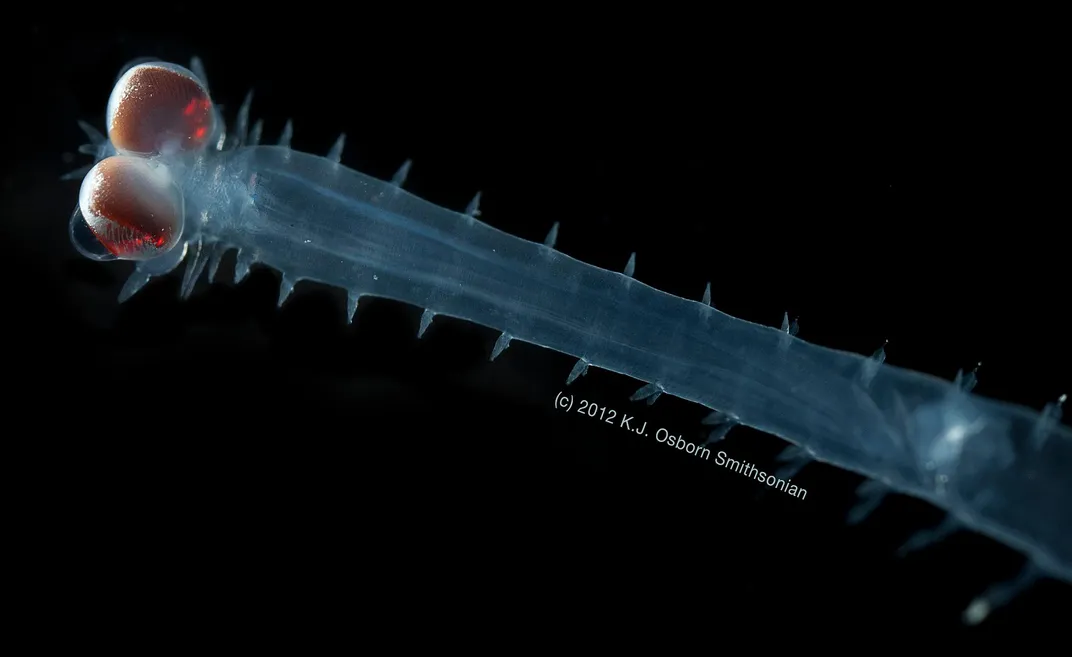
11. Some polychaete species have complex wide eyes
Alciopid polychaetes have large complex eyes that rival the camera-like eyes of cephalopods and vertebrates. They have corneas, irises, lenses and other structures necessary for high-resolution vision like ours. Furthermore, their retinas are directed toward the light, like those of cephalopods, instead of away, like ours, which means the worms lack the blind spot typical of vertebrates.
Most Alciopid species live in the top 650 feet of the ocean, where they can see by the light of the sun. They are relatively long worms with thin bodies—so thin that their eyes can be twice the width of their body. Their length makes it difficult to move swiftly or gracefully, but their keen vision stops them from becoming easy prey, because they can see a predator coming with enough time to get away.
12. Polychaetes often get up-close and personal with other invertebrates
Polychaetes aren’t always found in tubes or on the seafloor. Nearly 400 bristle worm species have been documented in relationships with other invertebrates. Some practice commensalism, where the bristle worms benefit from a relationship but don’t harm their host. Others practice parasitism, where the polychaete gains something at the expense of their host. One species—Arctonoe vittata—has been found living with more than 30 different invertebrate species, including alongside sea stars, crawling among the many moving tube feet. The tiny polychaete has a safe home, and the sea star can happily do its sea star thing. Finding a host is likely a challenge, but studies show that this bristle worm follows chemical signals from the host.
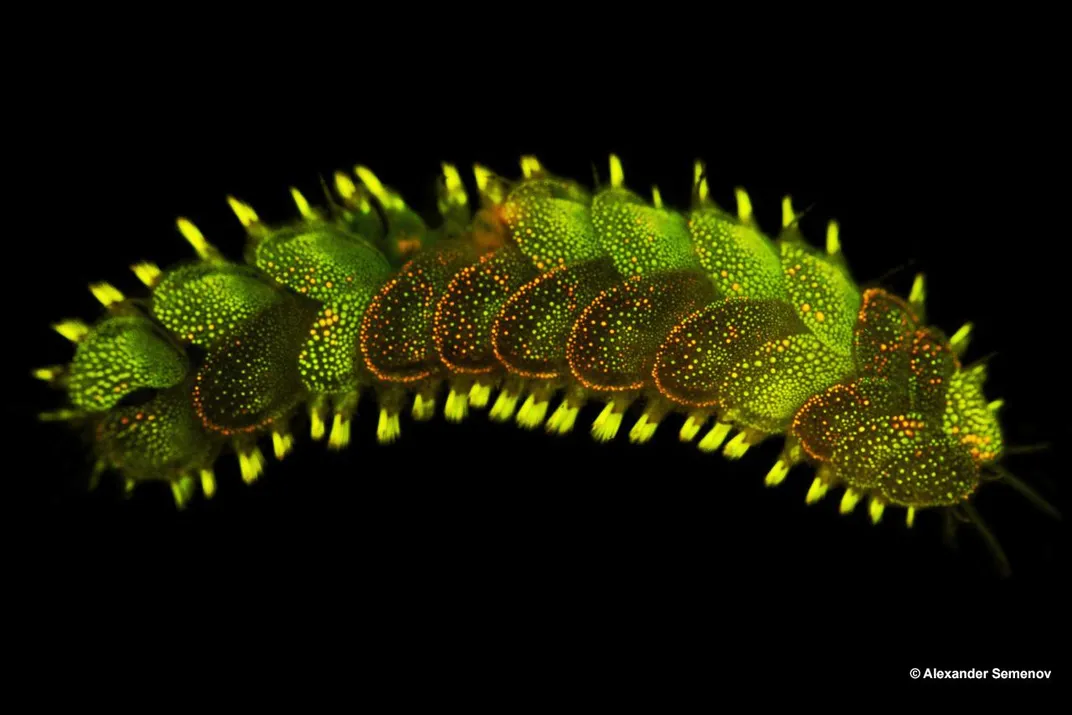
13. Scale worms are the pill bugs of the sea
Flat and covered with scales called elytra, scale worms look something like ocean-dwelling roly-polys. Their scales slough off and regenerate as a defensive mechanism. In some species, the scales produce bioluminescent light, which can leave a predator with a mouthful of glowing parts. That in turn advertises the unwitting animal's whereabouts to its own predators. Scale worms are carnivorous, feeding on other small invertebrates like crabs, sea stars, snails and even other polychaetes. Once you see their jaws, you can understand how these tiny worms can have their pick of the invertebrate buffet. Many are small, but there are some deep sea polynoids that can reach nearly a foot long, like the Eulagisca gigantea species found in Antarctica.
14. The "Squidworm" is really all worm
While exploring the deep water of the Celebes Sea in 2007, scientists working on the Census of Marine Life vacuumed up a strange chimeric animal. With the body of a polychaete and many long appendages on its head, they dubbed it "Squidworm," although in truth it is entirely worm. The squidworm (Teuthidodrilus samae) has ten tentacles on its head that are quite thick and nearly as long as its body. Eight are used for breathing and feeling, and the other two are for grabbing particulate food from the water. The worms also have six pairs of feathery sensory organs called nuchal organs that are essentially their version of a nose. The worms propel themselves with paddle-like parapodia and fans of golden bristles.
Its strange looks are compelling,but scientists find the squidworm fascinating because it seems to be a transitional species. It has features of both free-swimming and bottom-dwelling polychaetes, giving insight into bristle worm evolution. "It has done all sorts of peculiar things to its body," Fauchald told National Geographic after its discovery. "I'm delighted by it."
 Learn more about marine bristle worms and International Polychaete Day from the Smithsonian Ocean Portal.
Learn more about marine bristle worms and International Polychaete Day from the Smithsonian Ocean Portal.

